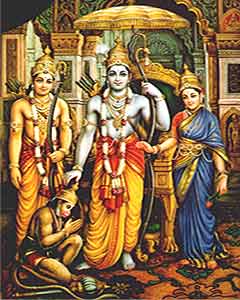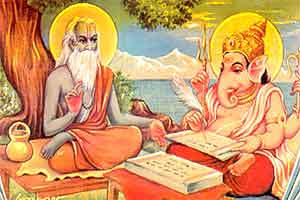 Vaishnavism, Sanskrit and Bishnupriya Manipuri Literature have had considerable influences on Manipuri Literature. Meidingu Pamheiba ruled Manipur from 1709-1748. Under his patronage Chaitanya`s school of Vaishnavism was propagated in Meitrabak. Angom Gopi was the renowned poet of the royal court during the reign of Meidingu Pamheiba. He was proficient in Meeteilon, Sanskrit and Bengali language. He translated Kritibas`s Ramayana and Gangadas`s Mahabharata into Meeteilon. His other books were - Parikhit, Langka Kanda, Aranya Kanda, Kishkindiya Kanda, Sundar Kanda and Uttara Kanda.
Vaishnavism, Sanskrit and Bishnupriya Manipuri Literature have had considerable influences on Manipuri Literature. Meidingu Pamheiba ruled Manipur from 1709-1748. Under his patronage Chaitanya`s school of Vaishnavism was propagated in Meitrabak. Angom Gopi was the renowned poet of the royal court during the reign of Meidingu Pamheiba. He was proficient in Meeteilon, Sanskrit and Bengali language. He translated Kritibas`s Ramayana and Gangadas`s Mahabharata into Meeteilon. His other books were - Parikhit, Langka Kanda, Aranya Kanda, Kishkindiya Kanda, Sundar Kanda and Uttara Kanda.
Historical accounts like Shomshok Ngamba have been written by two authors Laishram Aroi and Yumnam Atibar. Nungangbam Gobindaram was another writer of Pamheiba`s court. His literary works were - Pakhangba Nongaron , the translation of Astakal from Sanskrit to Meeteilon and Takhel Ngamba.
Another remarkable anonymous book of this period is - "Chothe Thangwai Pakhangba ".
In the later part of 18th century, Wangkhei Pundit Gopiram Singh was the scholar in the royal court of Medingu Chingthangkhomba (1763-1798). In case of any adversity, King used to consult with him. In 1789 Gobindaram had started the writing of "Meihaubaron Puya".
Wahengba Madhabram was the prominent scholar during the reign of Medingu Chingthangkhomba and Labainaya Chandra. The praiseworthy books written by him were - Langlon , Mahabharat Birat Parva, Chingthongkhomba Ganga Chatpa and Sana Manik . In 20th century, Langlon was first published in 1924 by Education Minister of Manipur, Waheingbam Yumjao Singh, with archaic and modern Meeteilon . It is also known as the "Sloka of Meetei Chaneika".
Literature of Bishnupriya Manipuri
 Bishnupriya Manipuri literature can be divided into two periods: Bishnupriya Manipuri literature and modern Bishnupriya Manipuri literature. Spiritual writing was prevalent. It has also been influenced by contemporary Bengali, Hindi, Assamese and Manipuri Meitei literature of Bangladesh, West-Bengal, Assam, Tripura and Manipur.
Bishnupriya Manipuri literature can be divided into two periods: Bishnupriya Manipuri literature and modern Bishnupriya Manipuri literature. Spiritual writing was prevalent. It has also been influenced by contemporary Bengali, Hindi, Assamese and Manipuri Meitei literature of Bangladesh, West-Bengal, Assam, Tripura and Manipur.
Bishnupriya Manipuri literature developed within a very short period. The ancient Bishnupriya Manipuri Literature is represented by folk stories, folk-songs, folk-poems, rhymes and proverbs. The language is archaic and is abound with words of Tibeto-Burman origin. The Bishnupriya Manipuris have established Bishnupriya Manipuri Sahitya Parishad, Bishnupriya Manipuri Sahitya Sabha, Bishnupriya Manipuri Sahitya Singlup, Pouri and Manipuri Theatre in order to encourage literary activities among the people of Manipur. A branch of modern Bishnupriya Manipuri literature comprised of Vaishnava Padavali that was based on Vaishnava philosophy.
Sanskrit also had an influence on Manipuri Literature. `Leithak Leikharol` was based on Sanskrit Puranas. Thawan Michak khengjaglon has the names of constellations in Sanskrit. Khwairakpam Chaoba Singh, Pukhrambam Parijit Singh and L. Kamal Singh were influenced by Sanskrit compositions.
Several classical compositions of Sanskrit and world literature was translated by Bishnupriya Manipuri writers. Srimadbhagabat Gita, Ishoponisad, Meghodutom and Ritu Samahar of Kalidas, Rubayaate-Umar-Khayam, Greek drama Anigone, Eliot`s The Waste Land, Japanese Haiku, Poems of Rabindranath Tagore are notable among them.













